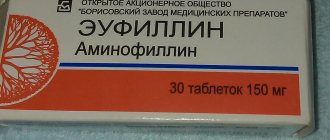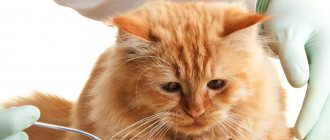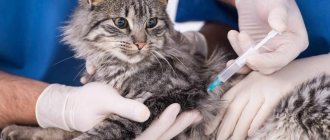6878Pavel
1
Ketorol for cats is a powerful pain reliever with a non-narcotic effect. In addition to the fact that the product effectively relieves pain in pets - cats and dogs, it promotes anti-inflammatory activity and provides an antipyretic effect. Veterinarians advise giving cats Ketorol to relieve varying degrees of pain, in particular those associated with traumatic injuries to organs and tissues.
Causes of pain and symptoms
Various factors and circumstances can cause pain in dogs and cats. These include :
- injuries - wounds, dislocations, fractures, sprains, burns, frostbite;
- inflammatory processes in tissues, including pathologies, infections, bacteria, external irritants, physical changes;
- tissue death;
- ischemia is a failure in the blood supply to tissues.
Signs that your cat is in pain may include this behavior::
- meow;
- rumbling;
- drowsiness;
- aggressiveness;
- refusal of food and water;
- toilet problems;
- the appearance of unusual sounds while going to the toilet.
In these cases, measures must be taken.
Types and forms of release of the drug
For cats, Ketorol can be used in two forms: injection solution and tablets. You can even inject cats with Ketorol yourself at home, but if there is a moderate pain syndrome, it is better to use the tablet form . Providing an analgesic effect, the main substance of the drug is absorbed through the gastrointestinal tract in the body and causes suppression of the formation of prostaglandins. Ketorol is able to effectively relieve pain, being the most powerful drug from the morphine group, and also more effective than aspirin.
How to give a pill to a cat and give an injection
All injections that the owner can give to the animal himself at home are usually done subcutaneously at the withers.
To do this, you need to fix the cat on a hard surface (with the help of a second person), pull up the skin at the withers and insert the syringe needle under the skin, the drug is infused slowly. Gently rub the injection site.
The tablet can be given using a special device, crushed and inserted into the oral cavity from a syringe without a needle with water or liquid food.
You can also take the animal by the scruff of the neck, secure it well on the floor, open its mouth and place the tablet on the root of the tongue. Then hold the mouth tightly with one hand, and with the other hand, carefully move it several times along the animal’s neck in order to evoke a swallowing reflex.
Principle of action and dosage
When the question arises whether a cat can take Ketorol, it is better to seek help from an experienced specialist. There are quite conflicting opinions regarding this drug for pets. The recommended substance is prescribed in the following cases :
- injuries, fractures;
- arthritis – rheumatoid, traumatic;
- postoperative periods;
- oncological diseases;
- inflammatory processes;
- other diseases that cause severe pain.
The optimal dose of the drug for cats is up to 1 mg per 1 kg of weight per day. Dosage of Ketorol for a cat in liquid form – 1 injection at night. But it is advisable to use this method of pain relief only as a last resort, since the substance has many side effects.
Can a cat be given Analgin?
Veterinarians do not give a clear answer to this question. Some experts prescribe an injection of Analgin-Diphenhydramine to reduce high fever, and the animal tolerates it normally.
In other cases, an unfavorable reaction to the drug is noted. Drooling, vomiting, diarrhea, convulsions, even death. Presumably, such side effects are caused by the active substance – Metamizole (Noramidopyrine). This is a non-steroidal anti-inflammatory drug that has special antispasmodic properties, characterized by increased salivation (salivation).
The use of Analgin, and indeed any “human” antispasmodics, is contraindicated in any animals due to its toxic effect on the bone marrow, kidneys and liver. By the way, Analgin is also excluded from human medicine; it is replaced with antispasmodics of new generations.
But I would like to note that this is only one of the opinions of veterinarians. Others insist that a one-time administration of Analgin will not cause harm. At the same time, everyone agrees that Aspirin, Paracetamol and any other “human” antipyretics are deadly for cats.
From the author. I would also like to note that in our nursery we have never taken risks and never used human antispasmodics. In case of serious injuries, we turned to competent surgeons; they have a large arsenal of veterinary drugs.
Painful sensations are a physiological reaction to disruptions in the full functioning of internal organs and systems. The manifestation of pain in a cat signals the need to provide assistance to the pet. There are situations when pain medication needs to be administered to your cat as soon as possible.
Features of use
When using Ketorol in ampoules, injections should be given intramuscularly at the cat's withers. At the indicated dosage of no more than 1 mg per 1 kg of weight, injections should be given 2 times a day. Otherwise, an overdose and poisoning of the cat with the indicated drug may occur. If such a situation occurs, it is necessary to rinse the cat’s stomach and consult a doctor. Symptoms of an overdose are :
- gagging and nausea;
- failure of kidney function - problems with urination appear;
- excessive sleepiness;
- disorientation.
It is better to seek help from a doctor so that he can individually prescribe the optimal dosage, taking into account the age, weight, existing problem and health status of the animal.
Indications for the use of pain medications for cats
Cats need pain relief in the following cases:
- cancer;
- previous surgery;
- dental treatment;
- fractures and ligament ruptures;
- otitis media;
- falling from a height;
- castration and sterilization;
- diseases of the nervous system;
- kidney disease;
- urolithiasis;
- inflammatory process of internal organs.
Painkillers for cats
Painkillers are divided into two types:
- with the presence of a narcotic substance in the composition;
- non-narcotic.
The first group belongs to the opioid category. The main active ingredient of the drug is morphine. Medicines act as a blocker and can provide pain relief for the most severe injuries and illnesses.
The second group includes non-steroidal anti-inflammatory drugs that can block moderate pain. In addition to eliminating painful sensations, their root cause is eliminated. Non-narcotic medications are not addictive. The drugs are actively used for diseases of the motor system.
A veterinarian who can identify the cause of the disease should select medications to relieve pain. The thoughtless use of drugs will only aggravate the situation and cause additional suffering to the pet.
The following symptoms and behavior patterns may indicate the need for urgent use of pain medication:
- increased/decreased (non-standard) degree of activity;
- desire to hide from a person;
- aggressiveness;
- loss of appetite;
- increased salivation;
- rapid breathing and pulse;
- stiffness of movements.
When is pain medication needed?
Pain syndrome can be acute and chronic. In case of severe injury or cancer, delay in providing assistance to your pet can lead to painful shock and even death.
Injuries most often occur during fights with dogs and other cats, when the animal is hit by a car, when falling out of a window or simply from a height.
Typically, pain in cats is accompanied by:
- Oncological diseases.
- Injuries - superficial extensive wounds and cuts, fractures of the paws and spine, bruises and torn ligaments.
- Postoperative period after surgery.
- Recovery after castration or sterilization.
- Chronic diseases in the acute stage - pancreatitis, cystitis, urolithiasis, others.
- Kidney or stomach colic.
- Disruption of the nervous system.
- Tooth and jaw pain (usually when enamel is destroyed).
Types of pain medications
In order to help your furry pet cope with painful sensations, you should give him a painkiller.
Medicines are used to relieve pain
Veterinarians prescribe in these cases:
- Drugs, the frequency of use of which is controlled by a specialist. It is advisable to use such drugs when diagnosing malignant tumors and severe injuries. The most effective narcotic medications include Omnopon, Codeine, Fentanyl and Tramadol.
- Non-steroidal anti-inflammatory drugs (NSAIDs for cats) are not addictive and help cope with various diseases. In case of an acute attack, this group of medications is not prescribed. The best drugs in this category are Ketofen and Ketonal, Quadrisol and Vetalgin.
- Other medications that are used in human therapy. In some cases, medications such as Baralgin, Pentalgin and Papaverine can be used for pain relief.
What drugs are prohibited for cats?
Some drugs that are used to treat people are prohibited from being used to treat pain in cats. The medications listed below cause stomach bleeding in pets and can cause their death.
A doctor must prescribe pain medication for a cat.
It is unacceptable to use drugs of the following type:
With great caution, only as prescribed by a veterinarian, you can use:
Traditional and alternative methods
If your pet is suffering from severe pain, you should not give preference to traditional methods of therapy. They are most often ineffective. Alternative methods of pain relief can be used only in cases of moderate severity.
In some cases, massage can relieve pain
It is very important to take the animal to an appointment with a veterinarian at the first sign of pain, who will determine the cause of the illness and prescribe the necessary medications. For mild manifestations of pain, an infusion prepared with chamomile, mint and lemon balm can help. The folk remedy helps to relax your pet and relieve pain.
To alleviate the animal’s suffering, you can use alternative methods of relieving pain, namely:
- Homeopathic remedies such as Traumatin, Traumeel. Medicines are made on a plant basis. They can only relieve mild pain. The duration of therapy exceeds 7 days. Quite often, Travmatin is used after castration of cats to relieve discomfort that causes anxiety to the animal.
- Manual therapy - massage. The procedures help improve blood circulation, relieve swelling, muscle spasms, and pain that arise from injuries.
- Compresses and heating pads used in the treatment of chronic diseases accompanied by pain and inflammation. With their help, you can effectively eliminate swelling.
- Acupuncture - acupuncture. The procedure helps relieve mild to moderate pain.
- Magnetotherapy, which helps eliminate pain and inflammation in the body.
Before deciding which way to relieve pain in a cat, it is necessary to identify the cause against which the syndrome developed.
Alternative ways to relieve a cat from pain
For toothache and traumatic lesions of the cat’s oral cavity, the drugs of choice are gels:
- Metrogil Denta;
- Homeopathic gel Traumatin;
- Dentavedin;
- Nibbler;
- Strong teeth (has a weak analgesic effect).
Treatment of the oral cavity for infectious inflammation should be aimed at eliminating pathogenic microorganisms. The surface of the gums near the affected tooth in a cat can be lubricated with a solution of chlorhexidine.
Acupuncture relieves pain from chronic diseases
- Magnetotherapy. Effectively eliminates the inflammatory process and reduces discomfort.
- Acupuncture. Helps with pain symptoms accompanying chronic diseases.
- Homeopathic medicines. They assume a long course and are not suitable for immediate relief of pain.
- Compresses. Relieves long-term pain. Eliminate traumatic swelling. Accelerate the healing of the wound surface.
- Massage. Kneads tissues, improves blood circulation. Relieves nagging pain from fractures.
To help your beloved pet you need to know the cause of the disease. Thoughtless use of medications will not only not help the cat, but will also increase suffering. Only a veterinarian is able to properly assess the situation and prescribe appropriate treatment.
The most popular drugs: dosages
What painkiller can you give your cat? Below are the most effective drugs from the category of painkillers that can be given to your feline pets.
Aspirin
Only a doctor can prescribe aspirin for pain relief for a kitten, since an overdose of acetylsalicylic acid, which occurs when a dose of 22 mgkg is introduced into the body, occurs:
- irritation of the gastrointestinal mucosa;
- stomach ulcer;
- internal bleeding.
Bone marrow function is suppressed. Kidney and liver failure develops. In particularly difficult situations, intoxication of the body develops - the pet dies or falls into a coma.
Aspirin should not be given to animals
Tramadol
Painkillers for cats, marketed under the name Tramadol, are most often prescribed when a four-legged friend is diagnosed with a severe bruise, fracture, or oncology. While taking the drug, side effects may develop such as:
- attacks of nausea;
- gagging;
- drowsiness;
- diarrhea.
The effect of the drug lasts 4-6 hours. Tramadol inhibits the respiratory and cough centers. The medication copes even with severe pain that accompanies neurological diseases, fractures and malignant neoplasms in the body.
Ketorol®
Often - more than 3%; less often - 1–3%; rarely - less than 1%.
From the digestive system:
often (especially in elderly patients over 65 years of age with a history of erosive and ulcerative lesions of the gastrointestinal tract) - gastralgia, diarrhea; less often - stomatitis, flatulence, constipation, vomiting, feeling of fullness in the stomach; rarely - nausea, erosive and ulcerative lesions of the gastrointestinal tract (including with perforation and/or bleeding - abdominal pain, spasm or burning in the epigastric region, melena, vomiting like “coffee grounds”, nausea, heartburn), cholestatic jaundice, hepatitis, hepatomegaly, acute pancreatitis.
From the urinary system:
rarely - acute renal failure, lower back pain with or without hematuria and/or azotemia, hemolytic uremic syndrome (hemolytic anemia, renal failure, thrombocytopenia, purpura), frequent urination, increased or decreased urine volume, nephritis, edema of renal origin.
From the senses:
rarely - hearing loss, ringing in the ears, visual impairment (including blurred vision).
From the respiratory system:
rarely - bronchospasm, shortness of breath, rhinitis, laryngeal edema.
From the side of the central nervous system:
often - headache, dizziness, drowsiness; rarely - aseptic meningitis (fever, severe headache, convulsions, stiffness of the neck and/or back muscles), hyperactivity (mood changes, anxiety), hallucinations, depression, psychosis.
From the cardiovascular system:
less often - increased blood pressure; rarely - pulmonary edema, fainting.
From the hematopoietic organs:
rarely - anemia, eosinophilia, leukopenia.
From the hemostasis system:
rarely - bleeding from a postoperative wound, nosebleeds, rectal bleeding.
From the skin:
less often - skin rash (including maculopapular rash), purpura; rarely - exfoliative dermatitis (fever with or without chills, redness, thickening or flaking of the skin, swelling and/or tenderness of the tonsils), urticaria, Stevens-Johnson syndrome, Lyell's syndrome.
Allergic reactions:
rarely - anaphylaxis or anaphylactoid reactions (change in facial skin color, skin rash, urticaria, skin itching, tachypnea or dyspnea, swelling of the eyelids, periorbital edema, shortness of breath, difficulty breathing, heaviness in the chest, wheezing).
Other:
often - swelling (face, legs, ankles, fingers, feet, weight gain); less often - increased sweating; rarely - swelling of the tongue, fever.
When to give your cat pain medication
Painkillers are given to animals in two cases: to relieve symptoms or to prevent their occurrence. In any case, the medicine is prescribed by a veterinarian. Pain is the body's reaction to an irritant. Each predator experiences suffering differently.
But there are a number of manifestations characteristic of all four-legged animals:
- a sharp change in behavior, the animal is too active or, on the contrary, passive;
- avoids communication, hides, shows aggression, hisses, scratches, tries to bite;
- restlessness: looking for a place, when he finds it he begins to “twirl”, trying to lie down comfortably;
- refusal to eat, does not even react to your favorite treat;
- ignores the litter box, trips to the toilet are accompanied by meowing;
- salivation, shortness of breath, rapid heartbeat.
Analgesics are prescribed in complex therapy for the following diseases:
- injuries, bruises, muscle strains;
- inflammatory processes in soft tissues;
- diseases of the joints and spine (arthritis, arthrosis);
- oncology;
- pathologies of the urinary system (urolithiasis, cystitis);
- pain syndromes after operations;
- abdominal muscle spasms caused by gastrointestinal diseases (constipation, bloating);
- neuralgia.
What painkiller can you give a cat: 10 safe drugs
Pharmaceutical veterinary products include thousands of pain relief products. When choosing a medication, not only the effectiveness, but also the harm caused is taken into account.
Relatively safe and effective medications:
- Vetalgin is an NSAID with analgesic and anti-inflammatory properties. Active pharmaceutical substance (API) diclofenac sodium. Prescribed as part of complex treatment for pathologies accompanied by inflammation and pain. Prohibited for kidney or liver problems, ulcers, or pregnancy.
- Quadrisol 5 is an NSAID for topical use. It is produced in the form of a gel containing vedaprofen. Used for acute and recurrent arthritis and arthrosis. Not prescribed for pets with kidney dysfunction, liver dysfunction, or gastrointestinal diseases.
- Rimadyl R is an NSAID with the API caprofen. Prescribed to relieve inflammation, analgesia in acute and chronic pathologies of the musculoskeletal system, after surgery. Prohibited for pregnant females.
- Ketonal is a long-acting NSAID. AFS ketoprofen. Prescribed for rheumatoid, psoriatic arthritis, arthrosis, gout, neuralgia. Helps with dental and cancer pain. Not prescribed for pathologies of the gastrointestinal tract, bleeding, renal failure.
- Meloxidil is an NSAID with an analgesic, anti-inflammatory, and anti-exudative effect. It is given for dislocations, arthrosis, edema, and tenosynovitis. Contraindicated in kittens under 6 weeks, pregnant females, hemorrhagic syndrome, stomach ulcers.
- Dexdomitor is an α2-adrenergic receptor antagonist. The active ingredient is dexmedetomidine hydrochloride. Causes depression of the central nervous system and an increase in the pain threshold. Prohibited for adults with heart failure, kidney dysfunction, and young animals under 3 months.
- Tramadol is an opiate analgesic prescribed to animals with cancer. Use with caution for liver and kidney dysfunction.
- Analgivet is a homeopathic remedy with the APS Aconitum napellus , which has no contraindications (with the exception of personal intolerance to the composition) and does not cause negative symptoms.
- Dexafort is a long-acting glucocorticosteroid. The active ingredient is dexamethasone. Prescribed to relieve post-traumatic swelling, joint pathologies, acute mastitis. Do not prescribe to animals with viral infections, osteoporosis, kidney damage, gastrointestinal tract.
- Ketofen is a French NSAID , it is a low-hazard drug and does not accumulate in the body. Indicated for arthrosis, injuries, dislocations, intervertebral hernias. Prohibited for stomach ulcers and kidney failure.
Medicines are given to pets only after consulting a doctor.
By-effect
NSAIDs are of great value in therapy for many cats, but the differences between cats and other animals require that only those drugs that have been specifically prescribed by a veterinarian be used for treatment. Many common “human” medications such as aspirin, ibuprofen and paracetamol/acetaminophen can be very toxic to cats and can be life threatening.
Like other medications, nonsteroidal anti-inflammatory drugs may cause side effects. For some cats, the risk of side effects may be higher (for example, older cats or cats with certain medical conditions). In such cases, the veterinarian may recommend increased monitoring to better tailor treatment and determine the lowest effective dose of the drug for the cat.
Licensed NSAID products are considered safe for use in cats. Please note that some drugs are licensed only for short-term use, others for long-term treatment. However, medications can still have side effects. Side effects are usually mild, but can sometimes be serious.
- Loss of appetite;
- Nausea, vomiting;
- Lethargy, depression;
- Changes in fluid requirements and/or frequency of urination;
- Diarrhea and/or black colored stools;
- Yellowing of the skin, gums, or whites of the eyes;
- Be sure to monitor the dosage and frequency of administration, as well as the duration of treatment. If in doubt, contact your veterinarian.
- NSAIDs are usually given to cats after meals. Your veterinarian may recommend switching to wet or canned food instead of dry food to help increase fluid intake—maintaining good fluid balance is very important.
- If the cat does not eat, DO NOT give medication, consult a doctor.
- Discuss with your veterinarian about monitoring your cat's condition to keep it healthy - how often the cat needs to be examined, what blood and urine tests are needed, how often this needs to be done.
- Never give your cat multiple medications at the same time without the direct recommendation of your veterinarian.
- If you have any doubts at any stage of treatment, or notice any side effects, stop giving the medicine and contact your veterinarian immediately.
We suggest you read: Calming a cat when he wants a cat, folk remedies and valerian
Remember that the cat's safety comes first. Following these simple rules will ensure that your cat receives proper treatment with the least risk of side effects.
Description
Paracetamol is a widely used drug used in humans as an antipyretic, anti-inflammatory and pain reliever. Paracetamol is included in more than 200 types of drugs, both individually and in combination with various additives (eg antihistamines, antitussives, vitamins, caffeine), and is available in the form of syrup, capsules, tablets and rectal suppositories for both adults and children.
The most common cause of poisoning of cats with paracetamol is the forced giving of it by the owner himself, when various signs of illness appear in the pet (eg fever, soreness, general depression), and more often, this occurs due to the wide availability of paracetamol in home medicine cabinets and the apparent safety of use for cats .
When it enters the stomach, paracetamol is quickly absorbed and enters the liver, where it must be metabolized (processed) into non-toxic products with medicinal properties. In cats, unlike many other animal species and humans, the liver does not contain a sufficient amount of enzymes capable of utilizing paracetamol, as a result of which it converts a significant amount of toxic substances.
The main target organ of paracetamol's toxic substances is the cat's red blood cells; as a result of their damage, normal hemoglobin turns into methemoglobin and is not able to transport oxygen to organs and tissues. After paracetamol poisoning, the blood of cats outwardly changes color significantly, acquiring a brown or bluish-blackish tint. Some red blood cells are completely destroyed after poisoning, leading to the development of anemia.
In dogs, unlike cats, the ability to metabolize paracetamol is somewhat higher and requires a higher dose of the drug, and the main target organ is not red blood cells but the liver. In dogs, like cats, there is no indication for the use of paracetamol in the treatment regimen; the main route of poisoning in them is the unintentional consumption of the drug left unattended and the deliberate poisoning of dogs by people in an attempt to control the number of stray animals.
The first signs of paracetamol poisoning in cats develop quite quickly, already 2-4 hours after administering the drug, first of all, the animals experience a change in the color of the mucous membranes, typically pink-brown with blue staining of the gums. Common signs in cats include weakness, rapid breathing and palpitations.
A presumptive diagnosis of high probability is established based on the history of administration of the drug with paracetamol, clinical signs and results of changes in blood color. A definitive diagnosis of paracetamol poisoning requires the use of a good third-party laboratory that can determine drug levels in serum or urine, but even in developed countries this type of testing is poorly available.
To exclude other diseases with similar clinical signs, a doctor at a veterinary clinic can conduct other research methods, such as a survey radiographic examination of the animal, ultrasound of the abdominal cavity, biochemical blood tests and some others.
Treatment
If an animal with paracetamol poisoning is delivered within the first hour after the drug enters the body, forced vomiting or gastric lavage (lavage) can be used, followed by the administration of activated charcoal. These measures are carried out to reduce the absorption of paracetamol from the gastrointestinal tract.
Further, a specific antidote (antidote) is N-acetylcysteine, its introduction into the body leads to an increase in the level of glutathione, which is able to bind the toxic substances of paracetamol. Initially, N-acetylcysteine is administered to the sick animal at a dose of 140 mg/kg intravenously or orally, followed by repeating every 6 hours at half the dose (for a total of 6 or 7 administrations).
Several other drugs such as ascorbic acid, methylene blue S-adenosylmethionine (SAMe), cimetidine can also be used to detoxify cats with paracetamol poisoning, but there is very little reliable data on their effectiveness and some have significant side effects.
As symptomatic and supportive therapy, inpatient veterinary clinics often use intravenous infusion of colloids and crystalloids, oxygen therapy, and sometimes blood transfusion (blood transfusion).
Forecasts
Paracetamol poisoning in cats is a very serious condition, the prognosis may depend on the dose of the drug administered and the time of initiation of adequate treatment.
Corrections regarding the duration of the course and the addition of therapy with other means are carried out exclusively by a specialist
Ketorol should be used for injection into a muscle or vein. The product is not suitable for spinal and epidural injections.
The number of injections per day, as a rule, does not exceed 2 times. This is due to the effectiveness of the product and its long-lasting effect.
It is allowed to use Ketorol for 5 days.
Corrections regarding the duration of the course and the addition of therapy with other means are carried out exclusively by a specialist.
Instructions on how to prick:
- An intramuscular injection is made with deep penetration into the muscle tissue. The product should be released slowly. The pharmacological effect declared by the manufacturer occurs after half an hour and lasts up to 6 hours. 1-2 hours after the injection, the peak analgesic effect is observed. A single dose per adult is 1-3 ampoules. For long-term treatment, the first dose can be 30 mg, subsequent doses are reduced to 10-15 mg.
- Intravenous administration of the drug is also carried out slowly with a solution release rate of 15 s/1 ml. Before the procedure, a clearly visible vein is selected (usually in the arms or in the chest area). The puncture site is treated with an antiseptic before and after administering the solution. It is not allowed to administer simultaneously with other drugs (put in the same syringe).
Do not use Ketorol in therapy where other NSAIDs are already used.
During studies of the drug, a number of side effects were identified.
- To eliminate problems, it is recommended to perform gastric lavage;
constipation or diarrhea; - feeling of heaviness in the stomach;
- vomit;
- the formation of erosions, ulcers on the walls of the stomach or intestines, bleeding;
- hepatitis;
- acute pancreatitis;
- jaundice (static type chole);
- hematomegaly (extremely rare);
- heartburn.
Respiratory system:
- dyspnea;
- rhinitis;
- bronchospasm;
- swelling in the throat area.
- lack of coordination;
- physical weakness;
- headache;
- increased tone of the back/neck muscles (strong resistance to bending and motor function of the body);
- altered psycho-emotional background (mood swings, hyperactivity, abruptly giving way to apathy);
- problems of various types with hearing, vision;
- hallucinations.
We suggest you familiarize yourself with: Fluffy long-haired cat breeds
Genitourinary system:
- pain in the lumbar girdle (may be accompanied by azotemia, hematuria);
- kidney dysfunction;
- change in the volume of urine produced, frequent urge to urinate;
- swelling associated with kidney dysfunction;
- nephritis (extremely rare).











